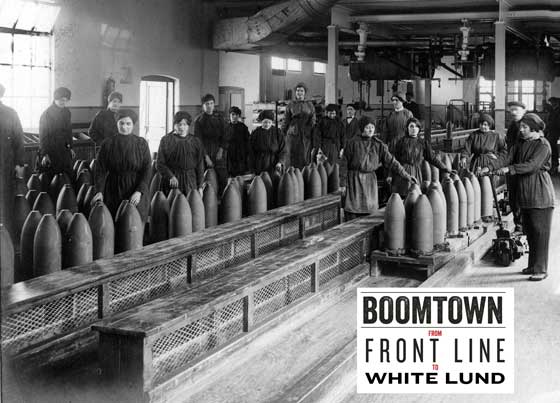The Great War Centenary
1917 - ExhibitionBoomtown - From
Front Line to White Lund
And it did not stop there....

Although the site was not brought back into production there were two
more explosions at White Lund.
On 5th April 1918 a team of 13 men were salvaging shells from the units
wrecked in the 1917 explosions. They were working out in the open,
removing plugs and containers from loaded shells. Two men died in this
explosion:
Richard Fryers, aged 47 years, from Morecambe and
Albert Greenwood, aged 35 years, from Burnley
On 14th January 1920 a group of six men were defusing bombs and
extracting gunpowder from a stockpile of French shrapnel shells. Two men
were there to mend a faulty light and one gentleman, a card writer, had
just entered the building to check the number of men at work. The cause
of the explosion is not known. The roof was blown off and part of the
wall demolished, all nine men were killed:
John Bush Birch, aged 36 years, a labourer
Stanley Bridson, aged 18 years, an electrician’s improver
John Cunliffe, aged 30 years, card writer
William Holden, aged 25 years
Walter Holland, aged 41 years, charge hand at the factory after serving
4 years in the war
Edward Oliver, aged 60 years
Frederick William Raeder, aged 18 years, a labourer who had
served 2 years in the army
Augustine Joseph Thompson, aged 23 years, electrician’s labourer
Wilfred Walker, aged 24
As work on the site ceased, the Ministry of Munitions started to sell
off the equipment and machinery on the site in a number of auctions.
Gradually, White Lund was cleared of the ordnance and was sold off in
1927. Shells were still found there from time to time during building
works on the site, including 12 6 inch shells reported in the local
paper in January 1956.
In 2003 new construction on the site turned up more shells and the
Explosive Ordnance Disposal of the Army were called in from Chester
whilst business were evacuated, including the Stagecoach bus garage.
After the second shell was discovered EOD got in touch with the museum
to ask if any maps existed of the site – but of course none that we had
– as the site was secret and excluded from maps!
Today’s industrial estate shows very little evidence of the original
Filling Factory, although the power house and a couple of other
buildings still remain. And may be the odd buried shell…..
© Images are copyright, Trustees of the King's Own Royal Regiment Museum.
You must seek permission prior to
publication of any of our images.
Only a proportion of our collections
are on display at anyone time. Certain items are on loan for display
in other institutions. An appointment is required to consult any of
our collections which are held in store.


